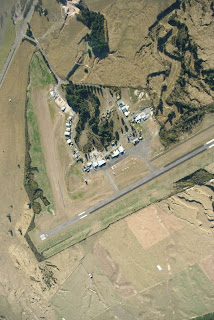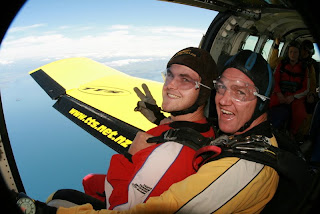We haven't really done much in the way of organised tours on this trip. It's partly because we prefer the freedom and flexibility of doing and seeing things in our own time and at our own pace (which is generally slow and leisurely). Also, tours always cost an absolute bomb and we're never entirely convinced that they'll be worth the money. If we can do it ourselves cheaper, we will.
Unfortunately this looked like it was going to be tricky in Chile. It was harder to identify the sights worth visiting, and our limited Spanish meant it would be an enormous challenge to visit them using just public transport (Jesus tried his best, but sometimes it takes more than 5 days to turn water into wine). Also, it didn't look like public buses went to many of these spots anyway.
So we decided that a tour was probably our best option. We signed up for a 4-day trip with Pachamama Tours (Pachamama means 'mother earth'), which would take us from La Serena to San Pedro de Atacama (in the north), stopping at various nature reserves and sights along the way. It turned out to be an interesting four days, and we saw way more than we would have if we'd been left to our own devices. Chile's a pretty big country so unfortunately there was also a lot of driving, and this combined with the amount of sight-seeing crammed into four days made for quite an exhausting trip. But well worth it.
We started off by spending the morning at the excellently named National Reserve Pinguino de Humboldt. We all boarded a small boat and set off for some islands in the distance, which never seemed to get any closer.
Another outing for my stunning pink waterproofs.
As you can probably tell, I wasn't particularly enjoying this boat trip.
Just as the choppiness of the sea and the seawater splashing in our faces was starting to make me feel a bit miserable, we came across these chaps lounging around on one of the islands:
There were loads of them snoozing on the rocks, rolling over to see the inconsiderate bunch of tourists that had disturbed their sleep.
For the next hour, the boat slowly made its way around the islands and we spotted more sealions and lots of awesome little penguins, waddling drunkenly and jumping clumsily across the rocks.
Right in the middle of this photo,
you can just about see a little pingu standing on a rock
We got a chance to get off the boat at Isla Dumas, walk around what felt like the coldest, windiest beach in the world and eat our sandwiches by the shelter of a big rock whilst being watched by enormous seagulls. We walked around the island a bit and found some super spiky cactuses (cacti, whatever):
Spiky. Not to be thrown at your girlfriend.
After an afternoon of driving, we arrived late in the evening at Bahia Inglesa, which is about a half hour drive from the town of Copiapo where the Chilean miners were trapped and rescued. Bahia Inglesa means 'English Bay' and is apparently named after an English pirate who arrived there in 1687. It turned out to be quite a suitable name – it had a freezing cold sea, grey skies and dog poo on the beach.
We were staying in cabins by the beach for a couple of days, and Karl and I decided to share with two fellow Brits, Poppy and Kayleigh, who were travelling Chile for a month. We've met lots of European travellers on our trip and, as lovely as they always are, they just don't have the same sense of humour. It was so nice to finally have other people to make stupid jokes about bums and farts with. For some reason, Europeans don't find that sort of thing very funny.
The next day we had a wander around the nearby town of Caldera and had some really good empanadas (pastry filled with meat and cheese) for lunch. In the evening, our tour guide Vanessa and driver Roderigo prepared an impressive BBQ and we spent the rest of the night drinking wine and feasting like kings.
Karl made friends with the local dogs, who had made themselves at home outside our cabin after taking a shine to Poppy and Kayleigh. Actually, it almost verged on stalking – earlier that afternoon, the dogs had followed them to the beach, sat on their towels with them while they sunbathed, and then escorted them home!
Leader of the pack
The next day we were back on the road, driving through the driest part of the Atacama desert to the city of Antafogasta. The landscape was like nothing we'd ever seen before. Dry and totally barren.
Along the way, we stopped at a service station in the middle of nowhere for some cazuela – a soup with meat, potatoes, pumpkin, corn on the cob, and rice:
We also visited a cemetery in the middle of the desert, near an abandoned nitrate mining town. Some of the graves were pretty elaborate:
A little further on was the 'Mano del Desierto' (the hand of the desert). It's an enormous hand sculpture that was installed as a greeting to those passing by.
Our group
High cinco!
Antafogasta turned out to be a bit of a shithole. Very grim and quite dirty. On the plus side though, we had some delicious churros. They taste like freshly made doughnuts, and they were filled with dulce de leche.
Tastes better than it looks. Honest.
The final day of our tour was probably the best. We wandered around a train cemetary. Because the desert is so dry and there's so little moisture in the air, the trains don't rust or corrode.
We stopped for some photos at the Atacama Salt Flats. All of these rocks are pure salt, and that big white thing in the distance in a huge salt cake. Obviously everyone felt the need to lick a rock and make sure it was salty.
We can confirm that the salt was salty
Unfortunately the salt tasting had an adverse effect on Karl, drawing all the moisture out of him until he was just three inches tall.
Pocket-sized Karl
It was all rather traumatic, but luckily there was an oasis nearby so we gave him a good soaking until he was restored to his former size.
Like one of those weird toys that expands when you soak it
in water. Except less slimy.
That evening we watched the sunset at the Natural Reserve Los Flamingos. The sunset was beautiful, but I had hoped to see more than four flamingoes.
Flamingoes from a distance
We arrived in San Pedro de Atacama after dark and headed out to a nearby restaurant for dinner and drinks. After eating, the waitress asked Karl in Spanish if he had enjoyed his meal. He misunderstood her question and answered 'No, gracias' (No, thank you), before realising his mistake and declaring 'Mucho gusto!' (Pleased to meet you!) instead. I guess it's going to take more than an act of God.
We're hoping to have a little more success with our Spanish in Argentina, our next stop, where we've heard they speak slower and clearer. If not, at least it'll make for some more funny anecdotes.







